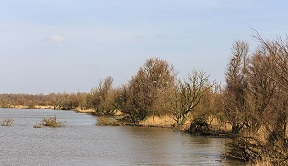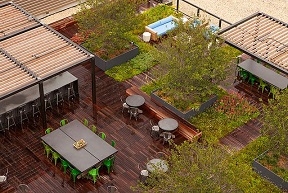Why are the ‘green’ areas in our cities often so uniform? Why are they ‘blandscaped’, to create virtually uniform green spaces that are devoid of local character or distinctiveness? Just attractive to look and easy to manage, but devoid of valuable biodiversity? We could do otherwise, by ecomimicry.

Urban monocultures
In The Conversation this week, Stuart Connop and Caroline Nash of the University of East London make a plea for ecomimicry in our cities. Meaning: designing the ‘green’ areas of the city in a way that maximizes their natural value. Biomimicry is well-known; it means constructing devices that work just like nature, for instance Velcro. Analogously, ecomimicry means creating an environment that works just like the natural world. An environment designed to reinforce conditions for natural processes. And yes, even urban landscapes can contain valuable biodiversity – if only we should take the trouble to design them with that in mind.
But at present, fashion dictates otherwise. ‘Globally,’ the authors write, ‘similarly generic designs abound, often using the same materials – and the same species.’ Just like monocultures in agriculture. This type of urban monoculture will create environments to the advantage of ‘urban generalists’ like pigeons and mice. Whereas less general species like hedgehogs and bumblebees need specific environments.
Careful neglect
Creating rich natural environments within cities is quite possible. But that will require more than substituting ‘something green’ for tarmac or concrete. We need to pay attention to natural habitat features, like soil type, complex plant structures, and hydrological patterns. And in so doing, create an environment that maximizes opportunities for local species.
We can draw inspiration from what happens when we leave areas unmanaged for some time. The authors of the article in The Conversation mention an unmanaged post-industrial site in Essex, Canvey Wick. There, nature has been allowed to thrive by itself. We can also mention the Oostvaardersplassen area in the Dutch Flevoland polder. It was retrieved from the water in 1968 and then left to its own. Originally, it was intended to become an industrial area. But it developed natural qualities so fast that in 1975 it was declared a natural area of national importance. In short, if we have enough patience to let areas develop on their own, natural areas of considerable quality may develop. But we could also speed up the process by designing the area with natural qualities in mind.

Ecomimicry: design inspired by nature
The emerging ecomimicry approach to urban design recognises the many lessons we can learn from the self-organising systems of the natural world. Nature is our best teacher. The ecomimicry approach starts with learning about the local landscape. If urban designers learn to know the regional ecosystem, they can design their landscape accordingly. The authors of the article in The Conversation mention respecting coastal treasures like dunes and mangrove forests. Or something simple as covering roofs in a typically local vegetation. Quite easy to combine this with rooftop solar!
Nevertheless, searching for ecomimicry on internet, one will find many design principles but very few ecomimicry projects. Among the good advice offered on internet are:
– Evolve solutions, don’t plan them!
– Don’t ask ‘what do I want to design’ but ‘what do I want the design to do’
– Identify organisms/ecological principles that have solved your problem.
In short, ecomimicry is ‘a strategy for developing and managing cultural landscapes, built upon a deep understanding of the structure and function of ecosystems.’ It will balance and sustain key ecosystem services, rather than maximize one service (e.g. food production) to the detriment of others.
Bringing back nature into our cities
Nature-based designs with ecomimicry at their core are coming. The EU Horizon 2020 project Connecting Nature works with cities worldwide to explore how to bring nature back into urban landscapes. That will require three things. We need to involve local ecologists who understand the unique complexities of the habitats being altered. In our approach to urban design, we should respect the value of all creatures. And we should embed this approach into policy, for it to have a lasting effect.
Interesting? Then also read:
Sustainable farming: a few development pathways
Insects: now it’s the time to cherish our little friends
The shelf life of green chemistry
